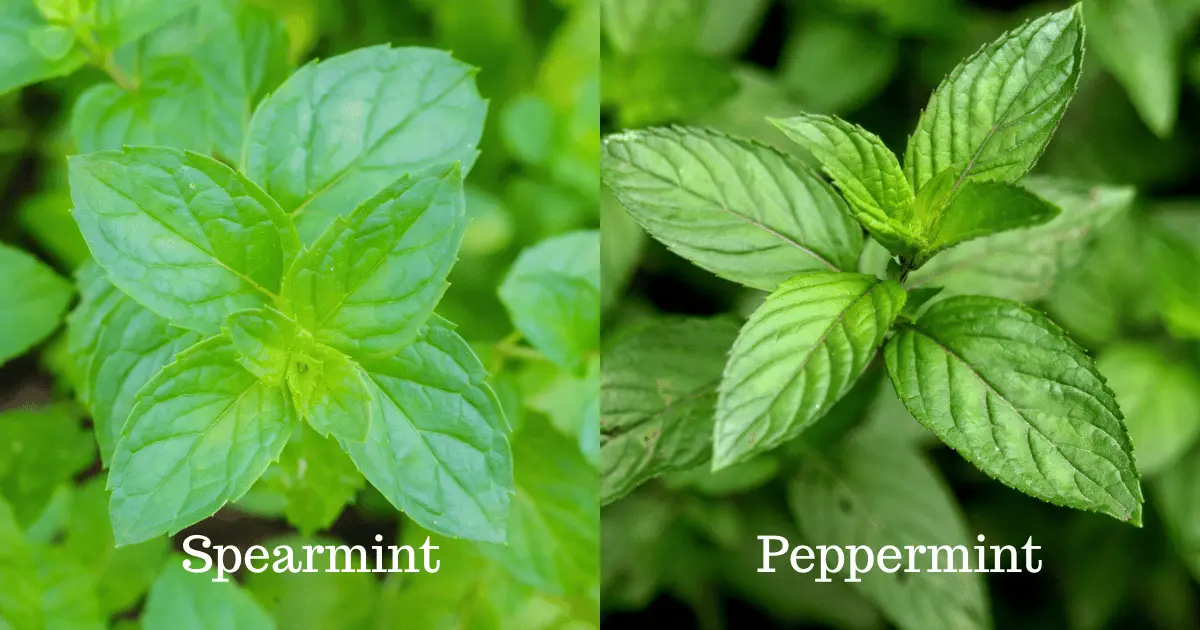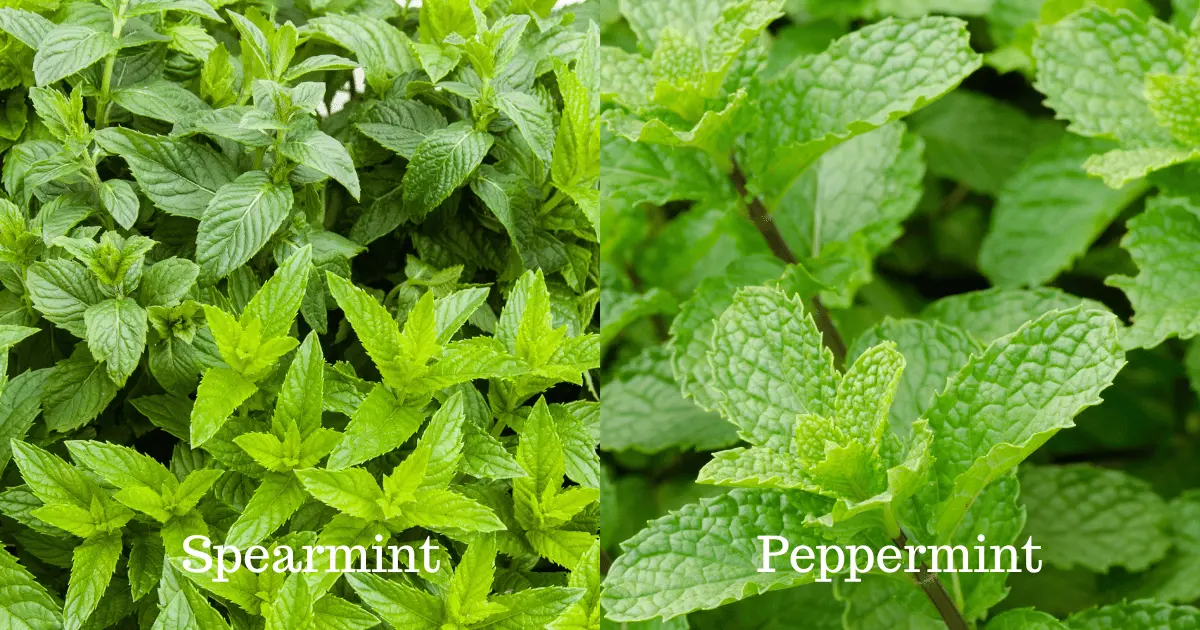Spearmint and peppermint are two popular mint strains used in cooking, and both mint species are used for cooking and medicinal purposes. Spearmint is always better with savory dishes, while peppermint is better for chocolate.
Spearmint vs Peppermint

Spearmint (Mentha x Spicata), native to Europe and southern temperate Asia, is from the Lamiaceae family. Spearmint gets its name from the shape of its leaves, and It’s a mint with a very sweet taste used in cooking. Its leaves look similar to regular mints with a spear shape and bright green color.
This mint is used in cooking dishes, chewing gum, toothpaste, etc. It contains vitamins, antioxidants, and vital nutrients. Healthwise, spearmint helps alleviate symptoms of nausea, indigestion, gas, headache, toothache, cramps, and sore throat.
Peppermint (Mentha x Piperita) belongs to the Mentha genus and the Piperita species. It is a cross between spearmint and water mint. It has some district cooking sensation when eating. It’s the natural hybrid of watermint and spearmint.
It contains the highest number of menthol, 40%; the menthol gives it a cool effect. It goes so well with sweet dishes. Peppermint has health benefits for irritable bowel syndrome (IBS), nausea, skin conditions, headaches, colds, and flu.
Comparison Table
Although similar, the difference is obvious, and some of these differences are:
| Characteristics | Spearmint | Peppermint |
| Botanical name | Mentha spicata | Mentha x Piperita |
| Species | Spicata | Piperita |
| Types | Naturally occurring plant | Fusion of watermint and spearmint |
| Growth | A straight plant that grows up to three feet. It also spreads indefinitely around the entire vegetation where it exists. | A low creeping plant that grows up to one and three feet. It does not spread widely and takes three feet in width in vegetation. |
| Leaf properties | Slightly smaller leaves Leaves grow directly from the branch. Smaller and wrinkled leaves | Larger leaves have more jagged leaves. Leaves grow on the stems of the plant. |
| Menthol concentration | Spearmint has a 0.05 percent menthol concentration | Peppermint has a 40 percent menthol concentration |
| Flowers | Flowers have a blue or pink bloom | Flowers have a purple bloom |
| Infusions | Apple mint, Pineapple mint, Smooth leaf mint, Curly mint | Orange mint, Grapefruit mint, Chocolate mint, and Ginger mint. |
| Flavors | Mild and sweet flavor, Delicate smell, and sweet taste | Sharp flavor with an intense smell. |
Menthol
They both contain menthol, but it varies. Spearmint has about 0.5% of menthol, and peppermint has about 0% of menthol. Hence, the hotness and coolness of both. Meanwhile, peppermint contains 40 percent menthol, so it packs up a powerful cooling punch, and its flavor is potent and spicy.
Taste
The difference is seen clearly in the taste. Spearmint has a lighter and sweet flavor, and peppermint has a sharp, almost spicy flavor because of the high percentage of menthol. The flavor of spearmint comes from Carvone which has a much sweeter taste and significantly less strong cooling effect.
Peppermint grows near rivers and ponds and has lots of mints, that’s why it is not popular for culinary uses. In contrast, spearmint contains a lesser percentage of menthol, which is preferable for health, drinks, and cooking.
Uses
Spearmint is used for foods and cosmetics, and its oil has beneficial uses, like reducing any swollen area in the body. Among the health benefits is Aids digestion, which stops nausea and vomiting after surgery.
Peppermint is used in peppermint tea and other herbs in herbal tea. It has traditional uses, too, for medicine for muscle pain or nerve pain.
It’s also used for flavoring ice cream, candy fruit, chewing gum, etc. its leaves are used for cooling effects. It can also be used as a fragrance.
Cultivation
Peppermint grows well in moist, shaded locations and expands by underground rhizomes. It’s an easy plant to grow in your garden or indoor garden.
This plant can grow up to 3 feet tall, depending on the condition of the area. It’s advisable to plant peppermint in early spring after the last frost of the winter has passed.
To plant, take a stem from an already established peppermint plant and place it in a glass of water in full sun. Most people choose to grow this plant in a container.
Make sure to use a plastic container to keep the soil moist. Place the container filled with soil in a location that gets sunlight. Plant your stems and consistently water them to aid good growth.
Growing Requirements

Watering
Water regularly, but do not overwater the spearmint plant. On the other hand, peppermint grows well with a very good water supply.
Light
Spearmint grows well in full to partial shade and can also be grown indoors on a bright windowsill. While peppermints aren’t exposed to direct sunlight, they are planted with partial sun to shade.
Soil
Both herbs grow best in rich, loamy, and moist soil, though they can grow along trailside ditches and craggy outcrops and can grow anywhere.
Temperature and Humidity
Spearmint grows well in almost all temperate climates. Most Gardners use pots as a start due to the invasive spreading of its rhizomes. Although, some spearmint plants prefer different materials and different lighting.
Spearmint grows well on part shade, moist soil with a slightly acidic PH. When it grows to 18-36, it is considered mature and ready to be transferred into the garden.
Peppermint thrives in USDA zones 5 and below. It is an unusually hardy plant and can survive light frosts but cannot endure extended cold snaps in cold climates.
Note: if you choose to start from the seed, start the process indoors eight to ten weeks before the last frost.
Fertilizer
Avoid fertilizing both plants as they grow well on their own. Thus, no need to add any form of artificial fertilizer.
Pests and diseases
Verticillium wilt is a major disease in peppermint. Mint rust – the leaves get small, a large area of leaf tissue dies, and leaves may also drop from the plant.
Aphids are caused by insects where the affected leaves change to green or yellow, which makes the leaves distorted. Cutworms- larvae show coloration and may curl up in C-shape. Other diseases include thrips and spider mites, among others.
